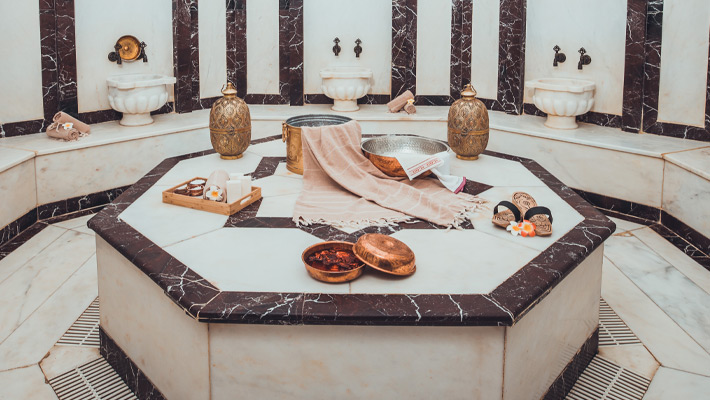Experience this Cultural and Relaxation Place.
Turkish hammam is a traditional bath ritual that has an important role in Turkish culture. Hammam is a social interaction place where heat and moisture used properly, body is cleaned and relaxed. You can general information about structure of Turkish hammam and how it works as follows:
Turkish hammam is built as a big building or facility commonly made with stone or marble. The entrance part of hammam consists of a space called ‘cold’. It is a transfer area where visitors get ready by taking off clothes. After the cold area it visitors move to another part called ‘hot’. Hot department is generally covered with big dome and in the middle it has heated stone platform or heating stone. Heating stone is an area where it is used for pouch and foam processes laid on it.
In Turkish hammam, visitors mostly lay on heating stone and heat their bodies. This process enlargement of skin pores and starts sweating process. At this stage, scrubbing can be applied by hammam therapists.
Pouch process is a process of gently rubbing full body by hammam therapist with special gloves. This process removes dead skin cells and dirt, cleans and smooths out skin. Pouch process is generally completed with hot water and freshens the skin. After pouch process, foam massage can be performed. The hammam therapist applies a generous amount of foam to your body with a foam sac and rubs it gently. Foam massage provides relaxation effect while cleaning the skin. In Turkish hammams, visitor mostly soend lots of time in hot section and then move to cold one. The body regains its normal heat in the cold section and can be moved to rest section. At this stage, generally light refreshing drinks is served.
Turkish hammam is a traditional bath ritual that is used to clean the body, freshen the skin, relax the muscles and generally provide relaxation. At the same time, it plays a big role as social interaction since people get together, chat and rest. Turkish hammam experience can be considered as a part of Turkish culture. It provides unique bath experience to visitors.
Let’s Take a Look at the features of Turkish Hammam…
Architectural Structure: Turkish hammams is commonly build with big stones or marbles. The architecture of the hammam generally has symmetric and aesthetic design. It has hot section covered with big dome and wide entrance sitting room.
Heating System: The hot part of the bath contains a heated stone platform or heating stone. The heated stone provides the warmth of the bath by spreading the heat. These stones are usually selected carefully and retain the heat for a long time.
Temperature and Moisture Balance: Temperature and moisture balance is important in Turkish hammams. The air inside the hammam is moisture and the temperature is usually kept at a moderate level. This environment allows the body to sweat and the skin pores to open.
Pouch and Foam: Pouch and foam processes have an important place in the Turkish hammam. Pouch is the process of rubbing the skin and removing dead skin cells using a special glove. Foam is a massage applied to the body with a foam sac. Both pouch and foam treatments help cleanse, smooth and provide relief to the skin.
Social Interaction: The Turkish hammam also plays an important role as an area of social interaction. People meet in the hammam, chat and relax. This allows the Turkish hammam to offer a social experience beyond just a physical cleansing and relaxation space.
Resting Areas: There are resting areas in Turkish hammams. The cold room is usually in the form of a large hall and offers visitors a space to relax and cool off. These areas often have cushions or sofas.
Cleaning and Hygiene: Turkish hammams are operated in a hygienic environment. Attention is paid to cleanliness and hygiene standards and visitors are provided with a comfortable and safe experience. It is important to clean and disinfect hammams regularly.











